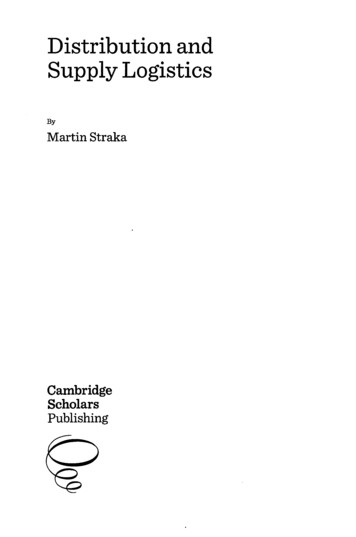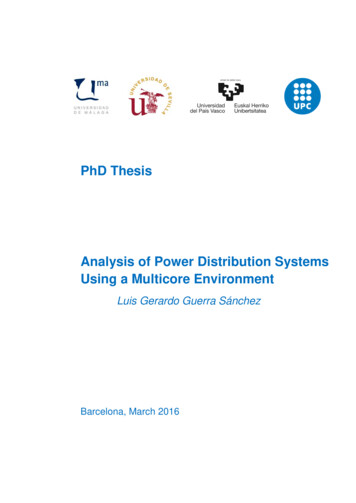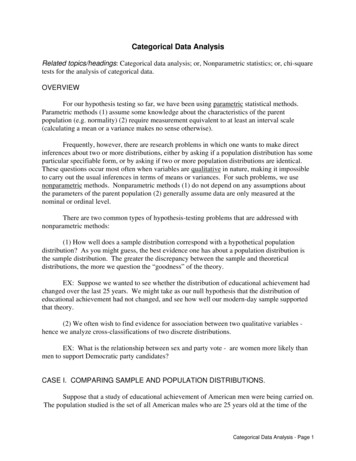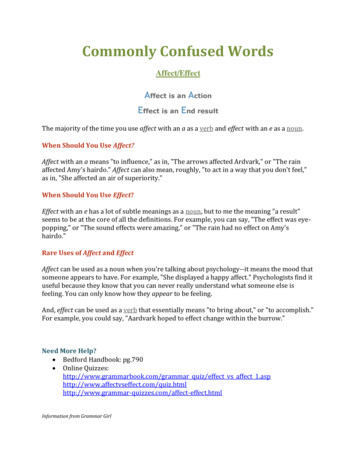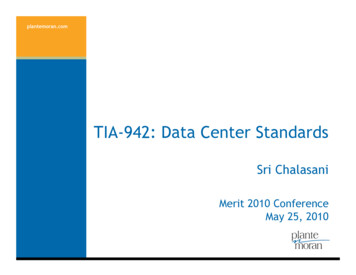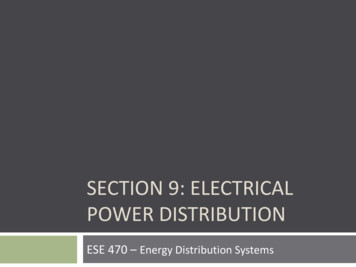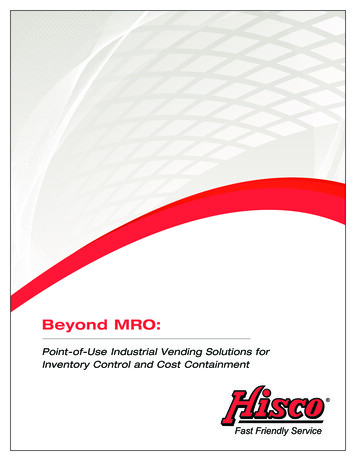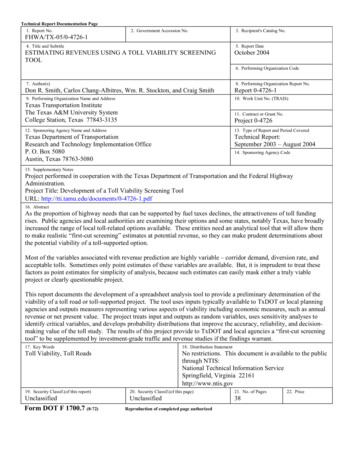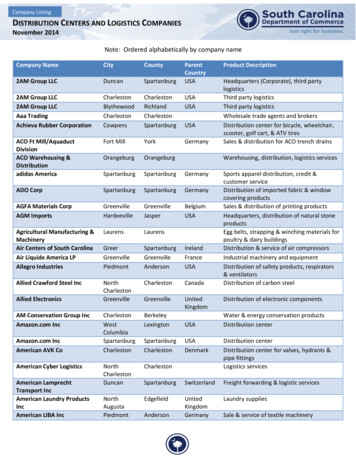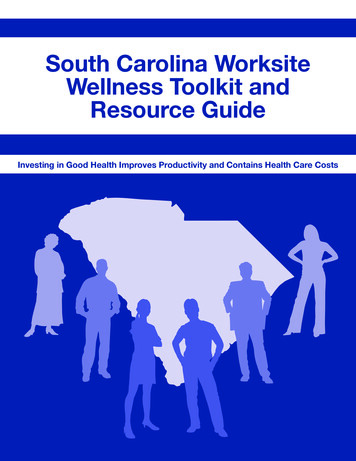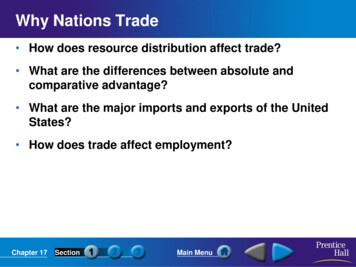
Transcription
Why Nations Trade How does resource distribution affect trade? What are the differences between absolute andcomparative advantage? What are the major imports and exports of the UnitedStates? How does trade affect employment?Chapter 17SectionMain Menu
Resource Distribution and Trade Each country of the world possesses different typesand quantities of land, labor, and capital resources. By specializing in the production of certain goods andservices, nations can use their resources moreefficiently. Specialization and trade can benefit all nations.Chapter 17SectionMain Menu
Absolute and Comparative Advantage A person or nation has anabsolute advantage when itcan produce a particular goodat a lower cost than anotherperson or nation. Comparative advantage is theability of one person or nationto produce a good at a loweropportunity cost than that ofanother person or nation.The law of comparative advantage states thatnations are better off when they produce goodsand services for which they have a comparativeadvantage in supplying.Chapter 17SectionMain Menu
Benefits of TradeIn this example, both Kate and Carlos benefit from specialization.Benefits from Specialization and Trade for Carl and KateCarlSpecializationKateTradeNet EffectSpecializationCarlChapter 17Carl trades 1 birdhousefor 2 T-shirts.SectionNet EffectKateKateCarl specializes,switching 2hours from Tshirt productionto birdhouseproduction.TradeCarlNet effect is samenumber of T-shirtsand 1 morebirdhouse.Kate specializes,switching 1 halfhour frombirdhouseproduction to Tshirt production.Main MenuCarl trades 2 T-shirtsfor 1 birdhouse.Net effect issame number ofbirdhouses and 1more T-shirt.
Imports and Exportsof the United StatesThe United States is theworld’s largest exporter.The United States is alsothe world’s largestimporter.The United States’ maintrading partners areCanada, Mexico andJapan.Chapter 17SectionMain Menu
Trade and Employment Workers who lose their jobs due to specialization facethree options:– Unemployment: Inability to adapt and find a new job– Relocation: Moving to where current skills meetcurrent jobs– Retraining: Gaining new human capital to meet thedemands of specialized labor marketsAs nations begin to specialize in certain goods,dramatic changes in the nation’s employmentpatterns also occur.Chapter 17SectionMain Menu
Section 1 Assessment1. Trade benefits both wealthy and poor countries because(a) self-sufficiency is too costly.(b) both wealthy and poor countries increase their wealth if they specialize.(c) both wealthy and poor countries lack human resources.(d) without trade neither wealthy nor poor countries could increase their wealth.2. What is the law of comparative advantage?(a) a country is better off producing goods for which they have a comparativeadvantage in supplying(b) a country that supplies things for others has a comparative advantage in trade(c) a country has a comparative advantage if it produces goods for export(d) a country’s greatest advantage is in the import of goods that it cannot produceWant to connect to the PHSchool.com link for this section? Click Here!Chapter 17SectionMain Menu
Section 1 Assessment1. Trade benefits both wealthy and poor countries because(a) self-sufficiency is too costly.(b) both wealthy and poor countries increase their wealth if they specialize.(c) both wealthy and poor countries lack human resources.(d) without trade neither wealthy nor poor countries could increase their wealth.2. What is the law of comparative advantage?(a) a country is better off producing goods for which they have a comparativeadvantage in supplying(b) a country that supplies things for others has a comparative advantage in trade(c) a country has a comparative advantage if it produces goods for export(d) a country’s greatest advantage is in the import of goods that it cannot produceWant to connect to the PHSchool.com link for this section? Click Here!Chapter 17SectionMain Menu
Trade Barriers and Agreements What are trade barriers? What are the effects of trade barriers? What is protectionism? What organizations promote international cooperationon matters of trade?Chapter 17SectionMain Menu
What Are Trade Barriers?A trade barrier is a means of preventing a foreign product orservice from freely entering a nation’s territory. Import Quotas– An import quota is a limit on the amount of a good that can beimported. Voluntary Export Restraints– A voluntary export restraint (VER) is a self-imposed limitation on thenumber of products shipped to a certain country. Tariffs– A tariff is a tax on imported goods, such as a customs duty. Other Barriers to Trade Other barriers to trade include high government licensing fees andcostly product standards.Chapter 17SectionMain Menu
The Effects of Trade RestrictionsIncreased Prices for Foreign Goods– Tariffs and other trade barriers increase the cost ofimported products, making domestic products morecompetitive.– Although manufacturers of many products maybenefit from trade barriers, consumers can lose out.Trade Wars– When one country restricts imports, its tradingpartner may impose its own retaliatory restrictions.Chapter 17SectionMain Menu
Arguments for ProtectionismProtectionism is the use of trade barriers to protect anation’s industries from foreign competition. Protecting Jobs– Protectionism shelters workers in industries that would be hurt byspecialization and trade. Protecting Infant Industries– Protectionist policies protect new industries in the early stages ofdevelopment. Safeguarding National Security– Certain industries may require protection from foreign competitionbecause their products are essential to the defense of the UnitedStates.Chapter 17SectionMain Menu
International Cooperation Recent trends have been toward lowering trade barriersand increasing trade through international tradeagreements. In 1948, the General Agreement on Tariffs and Trade(GATT) was established to reduce tariffs and expandworld trade. In 1995, the World Trade Organization (WTO) wasfounded to ensure compliance with GATT, to negotiatenew trade agreements, and to resolve trade disputes.Chapter 17SectionMain Menu
Global Trade AgreementsMany nations have formed regional trade organizations. These trade organizationsestablish free-trade zones, or regions where a group of countries has agreed toreduce trade barriers among themselves.Major Trade Organization OCEANEUCARICOMMERCOSURAPECNAFTA & APECChapter 17SectionMain Menu
Section 2 Assessment1. Protectionism does not(a) protect immigrant labor.(b) protect domestic jobs.(c) protect infant industries.(d) safeguard national security.2. Members of regional trade organizations generally work together to(a) abolish free-trade zones.(b) limit commerce between member states.(c) establish centrally planned economies.(d) eliminate trade barriers.Want to connect to the PHSchool.com link for this section? Click Here!Chapter 17SectionMain Menu
Section 2 Assessment1. Protectionism does not(a) protect immigrant labor.(b) protect domestic jobs.(c) protect infant industries.(d) safeguard national security.2. Members of regional trade organizations generally work together to(a) abolish free-trade zones.(b) limit commerce between member states.(c) establish centrally planned economies.(d) eliminate trade barriers.Want to connect to the PHSchool.com link for this section? Click Here!Chapter 17SectionMain Menu
Measuring Trade How do exchange rates affect international markets? How do exchange rate systems vary? What is a balance of trade? What is the United States trade deficit?Chapter 17SectionMain Menu
Exchange Rates and International Markets An increase in the value of a currency is calledappreciation. A decrease in the value of a currency is calleddepreciation. Multinational firms convert currencies on the foreignexchange market, a network of about 2,000 banks andother financial institutions.The value of a foreign nation’s currency in relation toyour own currency is called the exchange rate.Chapter 17SectionMain Menu
Reading an Exchange Rate TableThe following table shows an example of exchange rates.Foreign Exchange RatesU.S. Aust U.K. Canadian U.S. 10.64891.5990.6764Australian U.K. 1.5410.625210.40572.4651Canadian 1.4780.95932.365 en114.374.19182.9EuroMexican 7.34 en1Chinese icannuevo peso9.336.066.36.30.089.8111.13Chinese renminbi8.285.3713.255.60.078.79.81Chapter 17SectionMain Menu
Types of Exchange Rate SystemsFixed Exchange-Rate SystemsFlexible Exchange-Rate Systems A currency system in whichgovernments try to keep thevalues of their currenciesconstant against one anotheris called a fixed exchange-ratesystem. Flexible exchange-ratesystems allow the exchangerate to be determined bysupply and demand.Chapter 17SectionMain Menu
Balance of Trade When a nation exports morethan it imports, it has a tradesurplus. When a nation imports morethan it exports, it creates atrade deficit.The relationship between a nation’s imports andits exports is called its balance of trade.Chapter 17SectionMain Menu
The United States Trade Deficit The Trade Deficit– The United States has run a trade deficit since theearly 1970s. Why the Trade Deficit?– Imports of foreign oil as well as Americans’enjoyment of imported goods account in part for thelarge American trade deficit. Reducing the Trade Deficit– Quotas and other trade barriers can be used to raiseprices of foreign-made goods and urge consumersto buy domestic goods.Chapter 17SectionMain Menu
Section 3 Assessment1. When a nation imports more than it exports, economists say it has a(a) trade insufficiency.(b) trade deficit.(c) balance of payments.(d) trade surplus.2. When an economist says that a currency has become stronger, he or she meansthat(a) it will buy less foreign goods.(b) it can be exchanged for more of a foreign currency.(c) services, unlike goods, can be exported freely.(d) there are very few things that the currency cannot buy in a foreign market.Want to connect to the PHSchool.com link for this section? Click Here!Chapter 17SectionMain Menu
Section 3 Assessment1. When a nation imports more than it exports, economists say it has a(a) trade insufficiency.(b) trade deficit.(c) balance of payments.(d) trade surplus.2. When an economist says that a currency has become stronger, he or she meansthat(a) it will buy less foreign goods.(b) it can be exchanged for more of a foreign currency.(c) services, unlike goods, can be exported freely.(d) there are very few things that the currency cannot buy in a foreign market.Want to connect to the PHSchool.com link for this section? Click Here!Chapter 17SectionMain Menu
Chapter 17 Section Main Menu International Cooperation Recent trends have been toward lowering trade barriers and increasing trade through international trade agreements. In 1948, the General Agreement on Tariffs and Trade (GATT) was established to reduce tariffs and expand world trade. In 1995, the World Trade Organization (WTO) was
